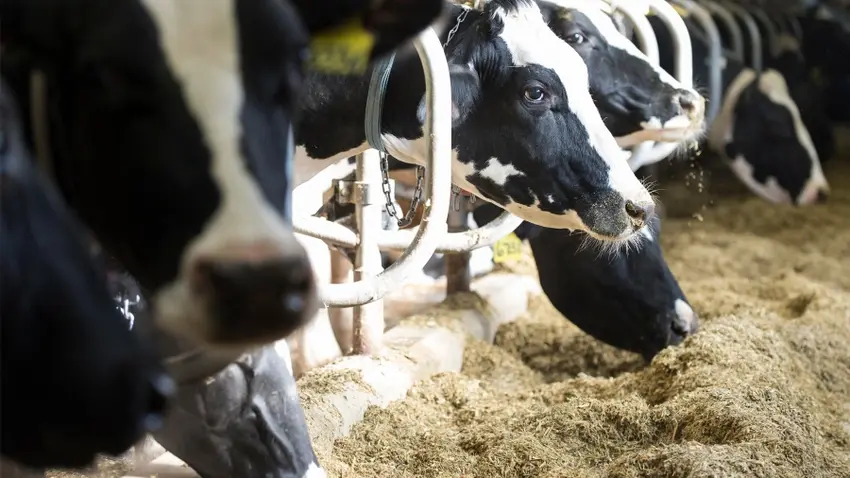Ben Buckner, Chief Grains and Dairy Analyst for AgResource Co., acknowledged during a recent...
Dairy Productivity More Than Pounds of Milk

Dairy Outlook: Both butterfat and protein content of U.S. milk are at record highs. Here’s what that means for dairy farmers.
Milk produced and shipped from U.S. dairy farms continues to evolve to meet market demand. Unlike No. 2 yellow dent corn that has a steady, largely unchanging nutrient composition consisting of starch, protein and water, milk shipped from U.S. farms has a far different nutrient composition and density than it did just one decade ago, according to Corey Geiger, lead dairy economist for CoBank.
Record-high milk components
From 2011 to 2020, U.S. butterfat percentages steadily climbed from 3.71% to 3.95%. By 2021, the U.S. milk supply surpassed its 3.98% record of 1945, and milk composition kept setting new standards to reach 4.11% butterfat in 2023.
“There’s certainly been an economic incentive to deliver more butterfat, as it was the leading milk component in 2023 and into 2024 for milk priced under multiple component pricing (MCP) provisions,” Geiger explains, noting that 58% of milk check revenue was derived from butterfat in 2023. “MCP covers about 92% of the U.S. milk supply.”
While not as dramatic, protein percentages found in milk have improved with each passing year and now stand at historic levels, too.
“This milk composition data is important to understand, and it requires a market reset when looking at U.S. milk production data and the nation’s ability to produce dairy products,” Geiger says.
It means that less milk shipped from U.S. dairy farms doesn’t equate to less dairy product output by U.S. processors. That’s because milk’s components become the dairy products that consumers enjoy, and the remaining water in milk largely is a byproduct.

Looking at USDA’s April Milk Production report helps glean more insight.
U.S. milk production fell for the 10th straight month in April at 0.4%, as reported by USDA in its May Milk Production report. The 69 million-pound-reduction, when comparing April 2023 to April 2024, was the smallest year-over-year monthly reduction since September 2023.
April’s milk composition tells a different production story, Geiger says.
“In April 2023, butterfat levels were 4.08% nationally based on Federal Milk Market Order data. Just one year later, butterfat climbed to 4.22%,” Geiger says. “While not as dramatic, protein also improved from 3.25% to 3.3% during the same 12-month period.”
These higher component percentages mean more nutrient-dense solids are available to make the dairy products U.S. consumers crave most.
While April milk production was down 0.4%, combined butterfat and protein production on a pound-basis climbed 2.2%. “That’s a net gain of 31.3 million pounds of combined fat and protein,” Geiger says.
Geiger does caution in this analysis; this is a ballpark figure of all the nation’s butterfat and protein percentage estimates, and it doesn’t include all milk. However, these math calculations are a strong indication of market trends.
USDA’s Dairy Products report also supports this narrative. In April, total cheese production rose for a second month in a row.
Cheese output rises
“Total cheese output was up 1.8% when compared to last April. The 1,186.6 million pounds of cheese production also set a new record for the month of April,” Geiger says. “This new record could not be possible without more milk components being delivered by milk shipments from America’s dairy farms.”
When looking at the combined components of both butterfat and protein over the past 10 months, total pounds were up nine of the 10 months.
“That’s in stark contrast to the 10 straight months of milk production reductions reported by USDA. The cumulative 10-month shortfall in milk production totaled 1.381 billion pounds,” Geiger explains. “If milk production took a downturn of this nature decades ago, dairy product production would follow suit. That isn’t happening in these modern times.”
Milk production has been USDA’s gold standard for measuring dairy productivity in the U.S. since 1931. However, milk composition has changed significantly since 2011, and butterfat and protein percentages are at record highs.
“From 2011 to 2023, butterfat pounds shipped from farms grew by 27.9% to reach 9.3 billion pounds,” Geiger says. “Meanwhile, milk production posted a smaller gain of 15.4% to reach 226.4 billion pounds.”
EDITOR’S TAKE:
The use of multiple component pricing overall has been a positive for the dairy industry. Dairy producers, through the use of genetics and feed formulations, have been able to increase desirable components that consumers demand, while at the same time reducing the total amount of milk shipped. That means dairy farmers are being paid more for the milk they do ship. This is a good reason to put them at the top of your prospect list. Dairy farmers do use a lot of trucks in their operations. Be sure to put that ever-increasing inventory on AgTruckTrader.com® and target the farmers/ranchers in your area!







